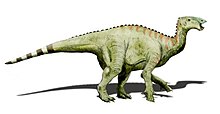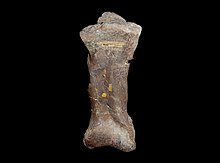| Hypselospinus Temporal range: early Valanginian ~140 Ma PreꞒ Ꞓ O S D C P T J K Pg N ↓ | |
|---|---|

| |
| Life restoration | |
| Scientific classification | |
| Domain: | Eukaryota |
| Kingdom: | Animalia |
| Phylum: | Chordata |
| Clade: | Dinosauria |
| Clade: | †Ornithischia |
| Clade: | †Neornithischia |
| Clade: | †Ornithopoda |
| Clade: | †Ankylopollexia |
| Clade: | †Styracosterna |
| Genus: | †Hypselospinus Norman, 2010 |
| Species: | †H. fittoni |
| Binomial name | |
| †Hypselospinus fittoni (Lydekker, 1889 ) | |
| Synonyms | |
Hypselospinus is a genus of iguanodontian dinosaur which was first described as a species of Iguanodon (I. fittoni) by Richard Lydekker in 1889, the specific name honouring William Henry Fitton.
History

In May 2010 the fossils comprising Hypselospinus were by David Norman reclassified as a separate genus, among them the holotype BMNH R1635, consisting of a left ilium, a sacrum, tail vertebrae and teeth. The generic name is derived from Greek hypselos, "high" and Latin spina, "thorn", in reference to the high vertebral spines. Later that same year, a second group of scientists independently re-classified I. fittoni into a new genus they named Wadhurstia, which thus is a junior objective synonym of Hypselospinus. Hypselospinus lived during the lower Valanginian stage, around 140 million years ago. A contemporary of Barilium (also once thought to be a species of Iguanodon), Hypselospinus was a lightly built iguanodontian estimated at 6 metres (19.7 ft) long. The species Iguanodon fittoni was described from remains discovered in 1886 alongside an unnamed ichthyosaur in the lower Valanginian-age Lower Cretaceous Wadhurst Clay of Shornden, East Sussex, England. Remains from Spain may also pertain to it. Norman (2004) wrote that three partial skeletons are known for it, but this is an error.
Hypselospinus is separated from Barilium on the basis of vertebral and pelvic characters, size, and build. For example, Barilium was more robust than Hypselospinus, with large Camptosaurus-like vertebrae featuring short neural spines, whereas Hypselospinus is known for its "long, narrow, and steeply inclined neural spines".
References
- Lydekker, Richard (1889). "Notes on New and other dinosaurian remains". Geological Magazine. 6 (8): 352–356. Bibcode:1889GeoM....6..352L. doi:10.1017/S0016756800176587.
- ^ Carpenter, K. and Ishida, Y. (2010). "Early and “Middle” Cretaceous Iguanodonts in Time and Space." Journal of Iberian Geology, 36 (2): 145-164.
- Norman, David B. (2010). "A taxonomy of iguanodontians (Dinosauria: Ornithopoda) from the lower Wealden Group (Cretaceous: Valanginian) of southern England" (PDF). Zootaxa. 2489: 47–66. doi:10.11646/zootaxa.2489.1.3.
- ^ Blows, W. T. (1997). "A review of Lower and middle Cretaceous dinosaurs from England". In Lucas, S.G.; Kirkland, J.I.; Estep J.W. (eds.). Lower and Middle Cretaceous Terrestrial Ecosystems. New Mexico Museum of Natural History and Science Bulletin, 14. New Mexico Museum of Natural History and Science. pp. 29–38.
- ^ Norman, David B. (2004). "Basal Iguanodontia". In Weishampel, D.B.; Dodson, P.; Osmólska H. (eds.). The Dinosauria (2nd ed.). Berkeley: University of California Press. pp. 413–437. ISBN 0-520-24209-2.
- Naish, Darren; Martill, David M. (2008). "Dinosaurs of Great Britain and the role of the Geological Society of London in their discovery: Ornithischia". Journal of the Geological Society, London. 165 (3): 613–623. Bibcode:2008JGSoc.165..613N. doi:10.1144/0016-76492007-154. S2CID 129624992.
| Taxon identifiers | |
|---|---|
| Hypselospinus | |
